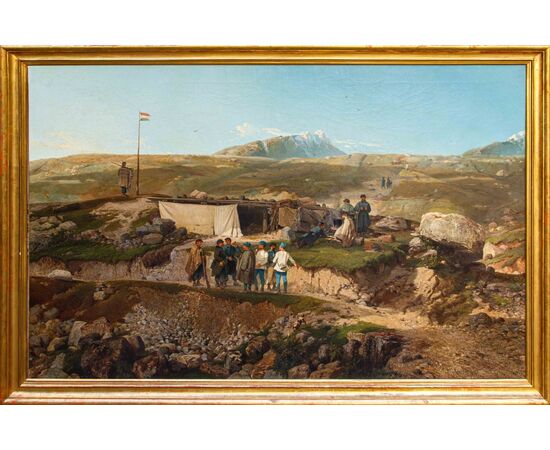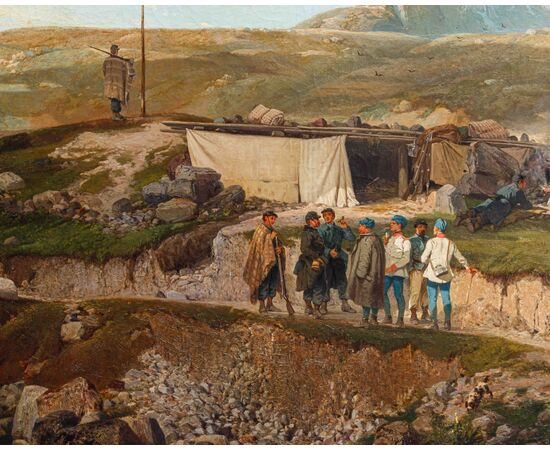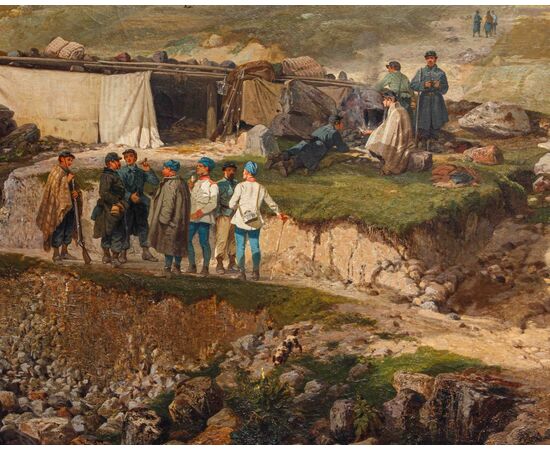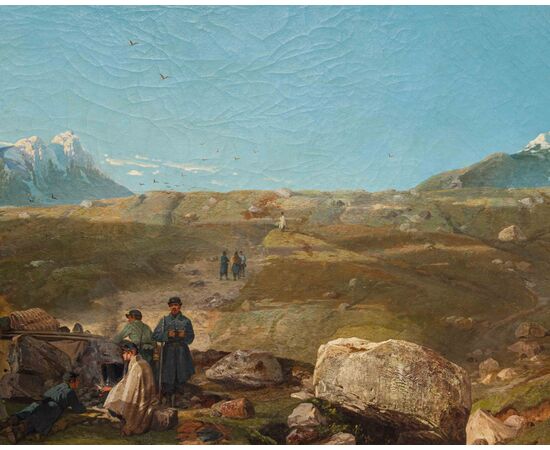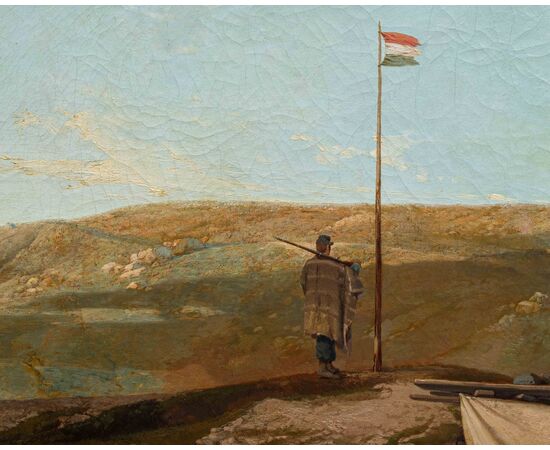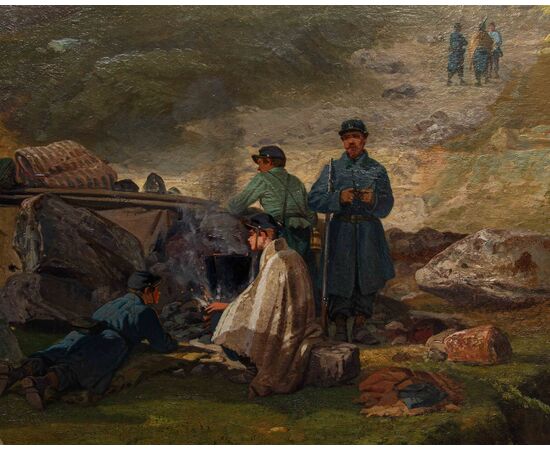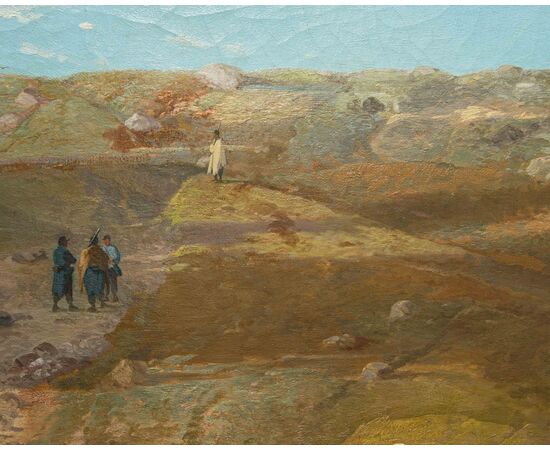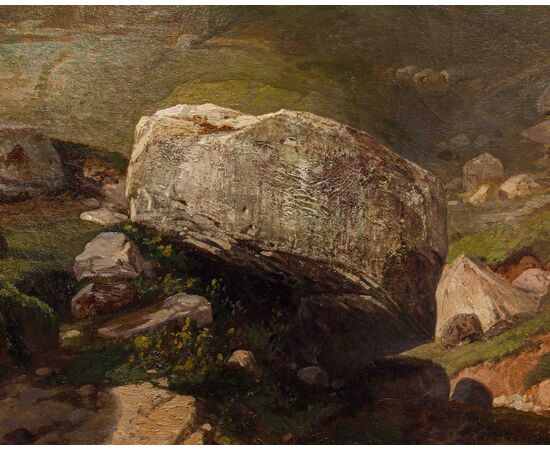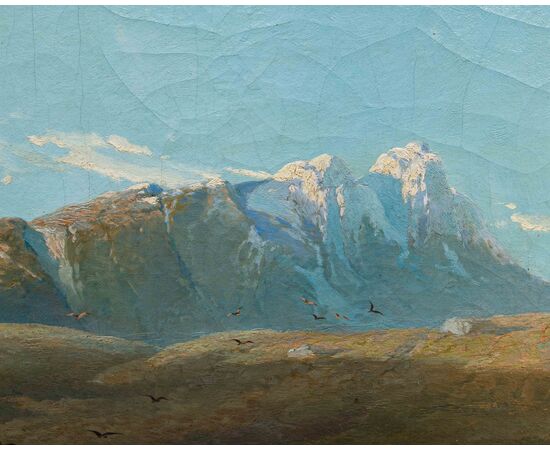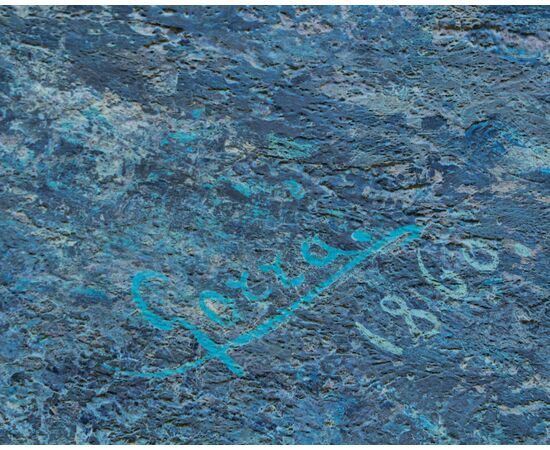Giulio Gorra (Cremona, 1832 – Turin, 1884), An episode of the Third War of Independence: the Tonale outpost of 1866
Giulio Gorra (Cremona, 1832 – Turin, 1884)
An episode of the Third War of Independence: the Tonale outpost of 1866
Oil on canvas, 136 x 203 cm
With frame, 153 x 220 cm
Signed and dated lower right
Signed on the back of the canvas
Bibliography Cf. Vedutismo e pittura di paesaggio nella Cremona dell'Ottocento. From Piccio to Giulio Gorra, exhibition catalogue, Teche Edizioni, Milan, 2002, page 76, IV 32. See also the engraving in Album della Guerra del 1866, 1866-67, Milan, Sonzogno, p. 21
Giulio Gorra, born in Cremona in 1832, was a painter whose artistic career falls within a crucial period of Italian history, that of the Risorgimento and the first decades of a united Italy. His production, while embracing different genres, is particularly significant for his historical subjects and for the portraits that immortalize the nascent Piedmontese bourgeoisie. Gorra's artistic training began in Cremona: he learned the first rudiments of painting from his father, who was also a painter and decorator. Gorra's studies continued at the Accademia Carrara in Bergamo, where he was a student of Enrico Scuri. After completing his artistic training, the young painter moved to Milan in 1857, where he found employment as an illustrator of newspapers and books and where he became close to the fervent political ideals of Garibaldi; in 1859 Gorra enlisted among Garibaldi's volunteers – he fought alongside the leader in the campaign for the liberation of Trentino from Austrian domination –, illustrating, in pen or pencil, various episodes of the military campaigns in which he participated. In his mature years, he settled in Turin, a city that would become the center of his activity. In Turin, Gorra came into contact with the lively artistic and cultural environment of the first Italian capital, which at that time was a melting pot of political and social ferments linked to the outcomes of the unification process. Gorra was an exponent of historical painting which, in the Risorgimento climate, had the purpose of celebrating national events and heroes, contributing to forging the identity and collective memory of the newborn Italian State. His historical canvases, often of large dimensions, were characterized by a solemn composition and a meticulous attention to historical details and customs, elements that reflected the influence of the academic painting of the time. Alongside historical painting, Gorra was an appreciated portraitist. The emerging bourgeoisie and the aristocracy of the North of the Peninsula relied on his brush to be immortalized. In his portraits, Gorra showed a remarkable ability in capturing the physiognomy and, often, the character of his models, returning a dignified and realistic image. These portraits are today precious testimonies of the clothing, accessories and poses that characterized the social elite of Piedmont and, more generally, of post-unification Italy. Despite his production being dominated by the genres of portraiture and historical painting, Gorra also tried his hand at genre painting and some scenes of daily life, always with a fidelity to truth and an attention to the rendering of materials and lights. His palette was often sober, but rich in nuances, and his brushstroke precise and controlled, in line with the academic canons of the time. Giulio Gorra participated in several exhibitions in Turin and other Italian cities, achieving good critical and public success. His career, unfortunately, was cut short by his death in Turin in 1884, at the age of only 52 years. Giulio Gorra's works are now kept in important museums and private collections, particularly in Piedmont and Lombardy, where they continue to offer a significant glimpse of Italian art in the second half of the nineteenth century, an era of great ideals and profound social and political transformations. His contribution is fundamental to understanding how art actively participated in the construction of the Italian national identity.
The painting in question represents the outpost of Austro-Hungarian troops near the Tonale pass in the context of the third war of independence of 1866. During the Third War of Independence, the Tonale Pass was a strategic point contested between the Italian and Austrian forces. The Italian Volunteer Corps, led by Garibaldi, had the task of controlling this front, together with the Stelvio and Lake Idro, to prepare for the advance towards Trento. The battle of Vezza d'Oglio, fought on July 4, 1866, saw an attempt by the Italians to repel the Austrian troops descending from the Tonale. The painting represents the moment after this clash, when Baron Franz Kuhn von Kuhnenfeld, depicted from behind, in the center of the scene, with a mustache and coat, verifies the state of the troops of the outpost. The representation of the conflicts that took place near the Tonale pass is common for Gorra's production: it is also reprised in an engraving on his drawing belonging to the collection Album della Guerra, published in Milan in 1866.

